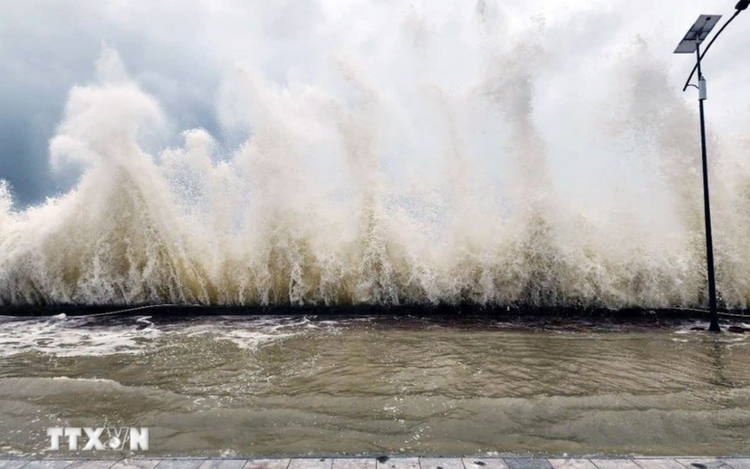
Some four or five more storms and tropical depressions will hit the East Vietnam Sea for the rest of the year. Photo: Vietnam News Agency
At a regular press briefing on Monday, Hoang Duc Cuong, deputy head of the administration, warned of heightened disaster risks, as severe weather patterns become more frequent and extreme.
From now until the end of 2025, the ENSO phenomenon – encompassing both El Niño and La Niña, linked to pressure oscillations between the eastern Pacific and eastern Indian Oceans – is forecast to remain in a neutral phase, with a tendency toward cooling, though not fully developing into a La Niña event.
“Based on the current trend, there will be the 12th storm over the East Vietnam Sea this year,” Cuong stated.
Information has surfaced on local social media claiming that the so-called 12th storm, named 'Ha Long,' will appear after storm No. 11 (Matmo).
However, meteorological systems have not yet identified the formation of storm No. 12, he said.
Some mistook this as the 12th storm, he said, explaining that in reality, Ha Long was the 22nd storm of the Northwest Pacific.
It did not enter the East Vietnam Sea, and thus was not counted among Vietnam’s numbered storms.
From October onward, cold air fronts are expected to increase in both intensity and frequency, particularly during November and December.
The northern region is likely to experience its first major cold spell in the second half of December, in line with long-term averages.
Many localities in central Vietnam might suffer heavy rainfall between October and mid-December.
Cuong also warned of high flood peaks between alert levels two and three on rivers from Quang Tri to Khanh Hoa and Lam Dong, with some locations likely to exceed alert level three.
These major flood events are expected mainly in October and November, with possible late-season floods overlapping with water storage operations at major reservoirs in the region.
“Flooding in large cities may worsen due to localized heavy rains, while mountainous areas will face a high risk of landslides and flash floods,” Cuong emphasized.
Storm damage, human losses
Since the start of the year, Vietnam has endured 20 types of natural disasters nationwide, said Nguyen Van Tien, deputy head of the Department of Dyke Management and Natural Disaster Prevention and Control.
These disasters have resulted in catastrophic human and economic losses: 221 people dead or missing, 362 injured, over 219,000 homes damaged or unroofed, more than 541,000 hectares of crops submerged, over 14,640 livestock and 1.36 million poultry killed or swept away, and 4,080 hectares of aquaculture areas ravaged.
The total estimated economic loss has reached over VND33.5 trillion (US$1.3 billion).
Notably, storm Bualoi, the 10th to hit the East Vietnam Sea this year, which made landfall in Ha Tinh Province, north-central Vietnam in late September, caused an estimated VND18.8 trillion ($712.5 million) in damage.
2025 storm season: a year of extremes
Vietnam has seen 14 storms and tropical depressions form over the East Vietnam Sea so far this year, significantly above the long-term average.
Six of these storms have directly or indirectly affected the country, creating a relentless cycle of disasters with little respite for recovery efforts.
The storm season began unusually early, with storm No. 1 (Wutip) appearing in June, the earliest storm in over 40 years.
Although Wutip did not make landfall, its circulation caused historic rainfall of 250 - 550 mm across central Vietnam, with some areas recording over 800 mm, Cuong said.
Storms No. 3 and No. 5 followed in quick succession, bringing winds of up to 135 kph and torrential rain, pushing river levels above dangerous thresholds in major rivers.
Typhoon Ragasa (storm No. 9) came at the end of September, which meteorologists now consider the strongest typhoon ever recorded in the East Vietnam Sea – even more powerful than 2024’s typhoon Yagi.
Ragasa was the first storm ever in Vietnam’s records to reach level 17, with gusts exceeding that level.
“Although Ragasa weakened before making landfall, it demonstrated the escalating danger of typhoons in a changing climate,” he said.
Immediately after Ragasa, storm No. 10 (Bualoi) struck Ha Tinh and northern Quang Tri with sustained winds of 89 - 133 kph and gusts reaching 150-166 kph.
The storm brought widespread rainfall of 300 - 600 mm, triggering devastating floods, landslides, and flash floods from northern to central provinces.
Storm Matmo, the 11th to form in the East Vietnam Sea this year, made landfall in Guangxi Province, southern China early on Monday, bringing heavy rains to northern Vietnam that are forecast to last through Tuesday.


Max: 1500 characters
There are no comments yet. Be the first to comment.